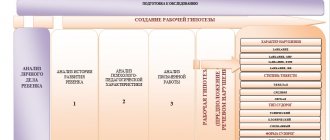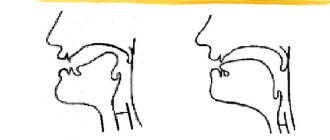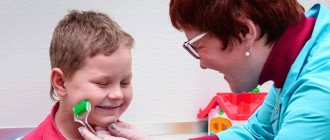A child who goes to 1st grade must be able to read and write. If there are any developmental deviations, it will be difficult for him to learn the material in class, and his performance will decline. To avoid this, you need to work with your baby from birth.
There is a certain sequence of sounds. If this is neglected, then various disturbances in the pronunciation of sounds will arise, which are considered in speech therapy from the point of view of the disease (sometimes they can be corrected).
Types of disorders of the pronunciation aspect of speech in speech therapy
Even a temporary delay in speech development can adversely affect the child’s overall development. Mastering correct speech is a necessary condition for mastering literacy and studying at school. In speech therapy, certain types of disorders are distinguished, which include alalia, dyslalia and dazarthria.
Alalia
Alalia is a complex disorder of speech development. It denotes the immaturity of all parts of speech as a result of the fact that the speech zones in the cerebral cortex were affected before birth and from 0 to 3 years.
In turn, alalia is divided into:
- motor;
- sensory.
It happens that a child has a mixed form of the disease, but one type is predominant. Motor (expressive) alalia can be corrected, while a child with sensory (impressive) alalia has physical hearing but does not understand what others say.
Dislalia
Dyslalia refers to disturbances in the pronunciation of sounds, but the child has good hearing and a normally developed articulatory apparatus. A child with this diagnosis misses, replaces, mixes or distorts sounds when pronouncing them. In speech therapy, dyslalia is considered a common disease.
Approximately 25-30% (sometimes 50%) of preschool-age children and 18-20% of primary school-age children are diagnosed with this speech disorder. If it is not corrected in time, in the future the child will not be able to fully master writing, and disorders such as dysgraphia and dyslexia may develop.
Dysarthria
With dysarthria, the central part of the analyzer (speech motor) is affected and the functioning of the muscles of the speech apparatus is disrupted. The child’s speech motor skills, sound pronunciation, and speech breathing suffer, so speech is inarticulate and slurred. If dysarthria is diagnosed, then a speech therapist, neurologist, or psychiatrist works with the baby.
Tongue twisters in English with the sound th
- Th irty- th ree th ousand and th irty th inkers th ought th irty- th ree th ousand and th irty th oughts.
- Th ree th erapists th rew th ree th ermometers in th ree th ick th ickets of th orny th istle.
- I am th ankful for a th ousand th ings … For fai th ful ear th , for bir th and brea th , for th ought and heal th and streng th and mir th , and, may be, when it comes, for dea th .
To conclude our training, as usual, we will take an example from a famous song with the sound th. I settled on the song “Under My Thumb” by The Rolling Stones. The word thumb
repeated throughout the song with a distinct pronunciation of the /θ/ sound.
Causes of speech disorders in children
A child’s speech can be delayed at any stage of its development for a variety of reasons. Such children often have a poor vocabulary that is not appropriate for their age group. The development of phrasal speech is somewhat delayed, and defects in the pronunciation of sounds persist for a long time.
One of the reasons for such a temporary delay in speech development may be various diseases suffered by the child at an early age. Speech development is greatly influenced by gastrointestinal diseases, as a result of which the nutrition of the whole body and the cerebral cortex is disrupted.
Speech disorders can also be caused by:
- fetal infection;
- lack of fetal oxygen;
- Rhesus conflict;
- risk of miscarriage;
- toxicosis;
- chronic high or low blood pressure in a pregnant woman or other diseases of the cardiovascular system;
- fall of the expectant mother, resulting in injury to the fetus;
- bad habits of a pregnant woman (smoking, alcohol, drugs);
- complex labor (including transient, protracted) or childbirth that began ahead of schedule;
- if obstetric instruments were used during childbirth;
- intracranial birth injury in a newborn;
- received traumatic brain injury from birth in early childhood;
- jaundice in a newborn (nuclear);
- genetic predisposition (one of the parents has a history of a disease associated with speech impairment);
- a child under 3 years of age often suffered from acute respiratory viral infections, pneumonia, rickets and other diseases;
- the baby underwent surgery using general anesthesia;
- a preschooler grows up in unfavorable social conditions;
- the child is diagnosed with cerebral palsy;
- the tongue or upper lip has a short frenulum;
- malocclusion, abnormal structure of the dentition or palate;
- The child has not developed phonemic hearing.
Among the etiological factors, social reasons can also be identified. If adults speak hastily, tongue-tied, dialectally, then the child will imitate them.
When the child is not engaged, then the preschooler is left to his own devices: he does not hear correct speech, they do not communicate with him, as a result of which he withdraws into himself, speaks little and poorly. If a family alternately speaks two languages, this can lead to speech impairment (dyslalia).
How do we pronounce it?
A person does not need special mobility of the lips or tongue to produce the sounds [v] or [f]. The correct articulation when pronouncing them is as follows.
- The lower lip is slightly retracted and turned outward (not bitten), pressing against the upper teeth.
- The upper lip rises slightly.
- The lips are not tense.
- The upper teeth are visible.
- The air is exhaled between the lower lip and upper teeth.
- When pronouncing the sound [f], there is no voice, the vocal cords are at rest.
- For the sound [in] you need to add a voice.
The only difference is the presence and absence of sound. Therefore, you can put the sound [in] through its voiceless pair.
Advice
When learning and consolidating pronunciation, do not focus your child’s attention on the fact that he does not know how to say a letter, do not scold him for this or reprimand him. On the contrary, by playing with him, unobtrusively help him master a complex phoneme. Excessive attention to the problem will cause unnecessary stress, which does not contribute to speech progress.
Negative impact on child development
The following have a negative impact on the development of a preschooler:
- TV;
- gadgets (tablets, smartphones, etc.);
- unfavorable conditions (lack of educational toys, books, places for games and for drawing, modeling);
- the child does not walk outside, has poor physical skills, has no responsibilities at home, and does not know how to look after himself according to his age;
- from a psychological point of view, a comfortable atmosphere in the family is not recognized (no trust, constant screaming, insults, punishment, as a result of which the baby experiences stress, lack of attention from adults, minimal or complete absence of physical contact, especially with the mother).
A preventive factor for the normal development of a child is planning a pregnancy.
When does a child need sound correction?
Moms often understand better what her child is saying. However, speech defects, which many parents do not notice for a long time, can cause development and communication problems for the child in the future. Before you start panicking that the child does not speak a certain sound and take action, you need to find out what sounds should be formed at a certain age:
- Up to 3 years old, the baby correctly pronounces the sounds - B-B, M-M, V-V, P-P, T-T, D-D, K-K, G-G, H-H, F-F, N-NY, Y. Possible softening of sounds - this is considered the norm.
- From 3 to 4 years old, the child learns to pronounce S-S, Z-ZZ;
- At the age of 4-5 years, a preschooler masters Sh, Zh, Ch, Shch, Ts.
- At about 5-6 years old, a child can already say R-R-L, L-L correctly.
Now that age norms are known, we can make an assessment: how the child pronounces the sound, whether he distorts it, or replaces it with a simpler one. If a sound is pronounced incorrectly, then it is necessary to correct the sound pronunciation. The child needs to be tutored (by parents, speech therapist), without tutoring the pronunciation will be even worse.
The work of a speech therapist is divided into 3 stages:
- Sound production.
- Sound automation.
- Difference of sounds.
It is not recommended for parents to make sounds on their own; this should be done by a professional - a speech therapist. But from the 2nd stage, parents can continue the learning process at home.
If there are other disorders of the speech apparatus, then the child must be shown to a neurologist. Individual complex treatment will be prescribed.
Before automation
To consolidate the result after setting the sound, you need to constantly, daily perform pronunciation practice exercises with your child.
- Repetition of a chain of syllables, where after [v] there are vowels. At first these will be chains of identical syllables (“va-va-va”, “vo-vo-vo” - and so on with all vowels), then you can build chains of different syllables (“you-va-voo”, “ve-va -in").
- Pronouncing words containing [v] at the beginning of the word (Vanya, you, water, cart, cotton wool, leader, bath, height, watch, carriage, wolf, veil).
- The same thing, only the phoneme must be inside the word (Ivan, cow, owl, sofa, halva, bed, fun, take out, pick, brood).
- Syllables with a combination of other consonants next to [v] (vku, vpa, tva, zvu, vkla, vra, vklyu).
- Words with such syllables (fall, foliage, inclusion, tasty, granddaughter, attachment, sound, insert, sound, contribution, title, power, taste, moisture, call, sound).
- Proverbs, sayings, tongue twisters, tongue twisters, riddles for practicing phonemes [c].
To prevent such exercises from being too boring and “educational”, turn them into a game: add music to the lessons, accompany the lessons with funny explanations, especially for tongue twisters. You can add movements and play them (this way you will help your child develop logarithmics). You can arrange an “exam” for parents: the baby names a complex syllable (twa), and the mother names the word in which it is present (decoction, fall off). Words whose meaning is unknown to the child are immediately explained. And if you also tell him interesting stories about the origin and meaning of sayings or proverbs, you will get educational play activities on speech development that the child will surely enjoy.
You can use pictures and cards that will help both mother and child.
Advice
It greatly simplifies the exercise of pronouncing different syllables with sound B by manipulating beads or buttons. They can be strung on a cord: one bead - one syllable, or laid out on a stencil (as in the picture), or simply “jump” with your fingers over the bumps and pronounce the syllables. At the same time, the mother pronounces the syllable, the child repeats.
It is important to play speech therapy games with your child when he is ready for it, and for as long as he can play without getting tired or distracted. It will be impossible to obtain a result against his will. This can only cause a response protest; the baby will withdraw into himself. Therefore, you need to “dose” classes according to age: up to 4 years old, 2 times a day for 5-7 minutes is enough, after 4 years – 2 times a day for 10-12 minutes. But if the child is a fidget, this schedule will have to be adjusted, breaking it down into a larger number of “approaches”, splitting up the lesson time.
Characteristics of OHP levels
General underdevelopment of speech in speech therapy is designated by the abbreviation OHP. This term refers to various types of speech disorders when components of speech (grammar, vocabulary, syllable and sound pronunciation) are impaired.
At the same time, the child has good hearing and intelligence. If you do not correct speech disorders with a preschooler until the age of 5, they may be diagnosed with ODD of a certain level. Depending on the degree of violation of OHP, there are 4 levels.
| Levels of general speech underdevelopment | Kinds | Symptoms |
| I level | Motor alalia | Non-speech manifestations: underdevelopment and poor development of large and fine motor skills, lack of self-care skills. Psychological manifestations: memory and attention are insufficiently developed, behavioral features - hyperactivity, disinhibition, inactivity or lethargy, low performance, increased fatigue. Speech manifestations: speech skills are formed late, some sounds are replaced by others, the child cannot repeat a syllable or word correctly, articulatory movements are performed with difficulty, a poor vocabulary, the child speaks in short phrases, mainly uses nouns in the initial form, speech is incoherent , the events are not presented sequentially. |
| Sensory alalia | Increased sensitivity to sounds of a different nature. The child pronounces meaningless sound combinations, fragments of words, unconsciously repeats other people’s words, replaces some sounds with others or skips them, combines parts of different words into one word, does not distinguish between paronymous words, and cannot correlate a word with an object or phenomenon. Attention, auditory perception, memory - difficulties arise with all of this. The child behaves impulsively, chaotically or inertly, withdrawn. During speech, they actively gesture and work with facial muscles. The speech is incoherent, it makes no sense, and others do not understand it. The child uses the “lip reading” technique to understand the speech of others. | |
| Aphasia | The child rearranges sounds and syllables, repeats phrases, activities, emotions, replaces sounds, combines elements of two expressions into one, cannot perform a sound-letter analysis of a word, all this is accompanied by problems with reading and writing. Speech mainly contains nouns, the infinitive form of the verb, long pauses, the strength and sonority of the voice is reduced, and the rhythmic and melodic aspects of speech are disrupted. | |
| Dysarthria | Unintelligibility, unclearness, poor intelligibility of speech. Weak articulatory motor skills, including respiratory muscles (rapid and intermittent breathing during speech activity). The child distorts, replaces or misses sounds, speech is slurred, slow, and inexpressive. The articulation of most sounds, including vowels, is impaired. Strength is reduced and the timbre of speech is changed. Mostly hissing and whistling sounds are pronounced interdentally or sideways; individual sounds are softened where this is not required. In severe cases, the speech motor muscles can be completely immobilized (paralysis). The child cannot differentiate sounds by ear, and is also unable to analyze and synthesize the sound structure of a word. Difficulties in communication and its insufficiency lead to a low vocabulary and inconsistency of words. | |
| Rhinolalia | Impaired breathing function, congenital malocclusion. The development of intelligence can be different (normal, with mental retardation or mental retardation of varying degrees). A baby under 1 year of age does not babble. The articulation of sounds is characterized by quietness or soundlessness. Speech development occurs with a delay - the child pronounces the first words only at the age of 2-3 years. Slurredness, inexpressiveness, incomprehensibility of speech. Some sounds are characterized by back-lingual or nasal pronunciation. The child is unable to differentiate sounds. The voice is dull and quiet. In order to make sound pronunciation more intelligible, the preschooler strains the articulation apparatus, as a result of which a grimace appears and the overall impression of what is said is reduced. In addition to inaccurate articulation and distorted sound pronunciation, the auditory distinction of sounds is disrupted, and there is an inability to perform phonemic analysis, resulting in writing disorders (dysgraphia and dyslexia). The vocabulary is not sufficiently formed, the words are not consistent with each other. | |
| Level II | Delayed speech development (the child pronounces phrases only at 3-4 years of age or later), sentences are mostly short, consisting of 2-3 words. In speech, auxiliary parts of speech and adjectives are used little. Speech is accompanied by gestures, words without morphological characteristics. The vocabulary is quite diverse, but significantly below the norm according to age. Children cannot name body parts, flowers, objects and their details, generalizing concepts. The child is not able to change a word, form a new one, use the word in the required case form, and does not distinguish words by numbers. The members of the proposal are not consistent with each other. The preschooler rearranges or shortens syllables, does not pronounce one consonant if they are nearby (“table-tol”). The child is unable to identify a particular sound and name its position in a word, or name examples for a given sound. During pronunciation, sounds are mixed and distorted. Soft consonants are replaced by hard ones, dull ones - by voiced ones, hissing ones - by whistling ones. Movements are uncoordinated, clumsy, finger praxis is not formed. Reduced auditory-verbal memory, poor attention, insufficient development of verbal and logical thinking, therefore, rapid fatigue is observed, the child is often distracted and makes many mistakes. | |
| Level III | Expanded phrases, consisting of 3-4 words, there are practically no complex sentences in speech. It occurs that the structure of phrases is disrupted, the main members of the sentence dominate in speech, and difficulties arise in the perception and structure of sentences. The child cannot correctly form the plural, decline words according to gender, person and case, and does not agree on nouns with adjectives and numerals. When a preschooler retells a text, he misses important points or presents them in the wrong sequence. The child understands speech almost close to normal for his age. Problems with the perception of logical and grammatical constructions with additional parts of the sentence, with understanding the meanings of complex prepositions, prefixes or suffixes. The vocabulary seems to be normal, but when constructing a phrase, the child does not know the name of this or that part of the object, does not distinguish the lexical meaning of words, and difficulties arise with the formation of new words. Phonetic defects: complex sounds are replaced by simple ones, voiced sounds are replaced by dull ones, hard ones are softened, whistling, hissing sounds, sounds L and L, R and Rb, words consisting of several syllables are pronounced incorrectly (the child rearranges them or skips them). A preschooler cannot determine the first and last sound in a word, and cannot find words for a given sound. | |
| IV level | Speech is a little blurred and inexpressive, as the articulation is unclear. The child cannot differentiate between sibilants and affricates. There are no gross violations in sound pronunciation. Difficulties arise with pronouncing words consisting of several syllables (the preschooler skips, rearranges, reduces the number of sounds and syllables). There are problems with understanding the lexical meaning of a word, individual concepts are often confused (“drawing” - “coloring”), the child cannot explain the meaning of proverbs, phraseological units, choose a synonym and antonym, or form a new word. The preschooler incorrectly agrees with nouns, numerals, and adjectives, forms the plural form of words with errors, and uses prepositions incorrectly. When choosing a right and wrong word, the child chooses the correct option. During a story or retelling of a given text, the child breaks the sequence of actions and events, has difficulty identifying what was important and what was secondary, and may repeat some points several times. | |
What sounds does the speech therapist start with?
The sequence of sounds in speech therapy begins with those sounds that the child already pronounces at the age of 3 years. The sounds are predominantly simple for the articulatory apparatus; they are also reference (more complex sounds are based on them). Such sounds include vowels and consonants: B-B, M-M, V-V, P-P, T-T, D-D, K-K, G-G, H-H, F-F, N -NY, Y.
The sequence of sounds is performed gradually. In speech therapy, it is recommended to start working on sounds that are familiar to the baby and he pronounces them well.
English tongue twisters with th sound
- Th ese bro th ers ba th e wi th th ose bro th ers, th ose bro th ers ba th e wi th th ese bro th ers.
- Th ey are always bo th ering Fa th er and Mo th er to do things for th em.
- Th ese clo th es are ra th er for th e southern wea th er, th ose clo th es are ra th er for th e northern wea th er.
By the way, I highly recommend following the link and studying another tongue twister. More precisely, these are many different tongue twisters in unvoiced and voiced th, which are set to music. Learn this song, and your articulatory apparatus will never forget the correct position.








